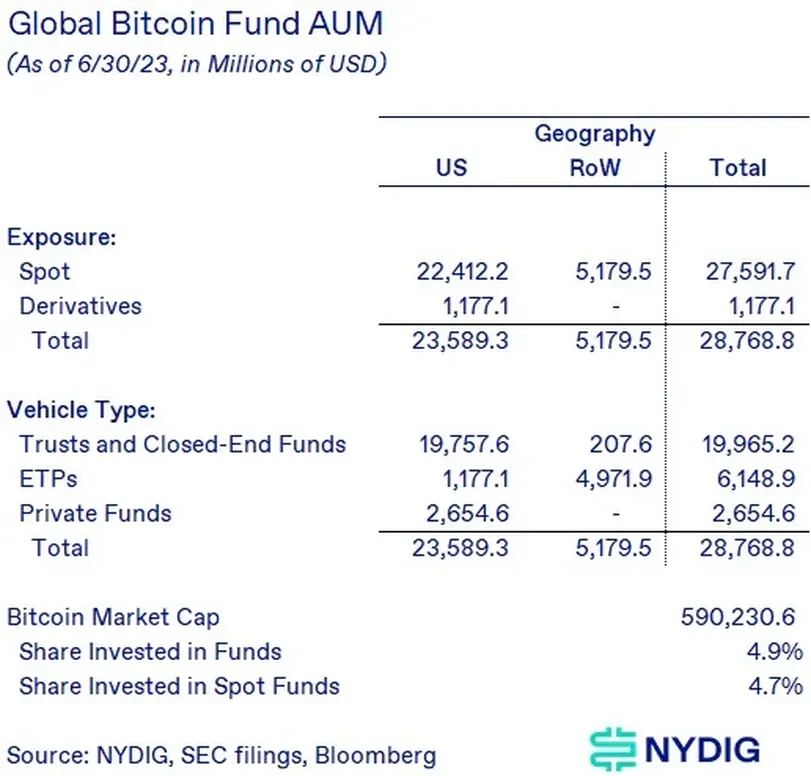- According to NYDIG’s latest research report, spot Bitcoin-based exchange-traded funds (ETFs) could bring in $30 billion in new demand for the world’s largest digital asset.
- Bitcoin is often referred to as digital gold, so comparisons can be made with gold ETFs listed in the early 2000s.
- While over $210 billion is invested in gold funds, there are only $28.8 billion worth of Bitcoin funds.
In its latest research report, NYDIG explained how spot Bitcoin ETFs could attract $30 billion in capital.
Bitcoin ETFs Could Provide Massive Capital Inflow
According to NYDIG’s latest research report, spot Bitcoin-based exchange-traded funds (ETFs) could bring in $30 billion in new demand for the world’s largest digital asset. In recent weeks, the frenzy around spot ETFs has engulfed the crypto market thanks to applications made by BlackRock (BLK), Fidelity, and others.
The NYDIG report stated:
“The recognition of the BlackRock and iShares brands, familiarity with securities-based purchase and sale methods, simplicity of position reporting, risk measurement, and tax reporting can bring some notable benefits compared to existing alternatives.”
NYDIG has already modeled $28.8 billion in accumulated Bitcoin assets and $27.6 billion in similar spot products.
Bitcoin is often referred to as digital gold, so comparisons can be made with gold ETFs listed in the early 2000s. Currently, gold ETFs hold only 1.6% of the total global gold supply, while central banks hold 17.1%, and Bitcoin funds hold 4.9% of the total Bitcoin supply.
There is a significant difference in demand between digital and analog assets in funds: while over $210 billion is invested in gold funds, there are only $28.8 billion worth of Bitcoin funds.
Bitcoin is approximately 3.6 times more volatile than gold, which means that, on an equivalent volatility basis, investors would need 3.6 times less Bitcoin in dollar terms instead of gold for the same level of risk exposure. NYDIG reported the following:
“Bitcoin is approximately 3.6 times more volatile than gold, so on a volatility equivalent basis, investors would need 3.6 times less Bitcoin in dollar terms than gold for the same level of risk exposure. Nevertheless, this would result in approximately $30 billion in increased demand for a Bitcoin ETF.”
Comparing Gold ETFs to Bitcoin Can Be Misleading
According to Ecoinometrics, the GLD ETF filled a significant gap in the market by offering an easily tradable product that tracks the price of physical gold. However, comparisons between gold ETFs and Bitcoin ETFs can be potentially misleading, as the significant increase in the price of gold is largely due to a positive macro environment and a weakening dollar.
The following was stated about the GLD ETF and Bitcoin ETF:
“Therefore, the GLD ETF definitely didn’t hurt and probably brought some nice inflows into the gold market, but it was really in the driver’s seat macro-wise at that time. A spot Bitcoin ETF could generate more interest in Bitcoin and undoubtedly help attract fresh money to the space. However, it doesn’t guarantee that a Bitcoin will be worth $100,000 on its own.”
The true potential of a Bitcoin ETF is achieved through the combination of the ETF’s launch, a weak US dollar, the Federal Reserve’s Quantitative Easing path, and the convergence of the trend of the younger generation’s accumulation transfer towards cryptocurrency, it was stated.

